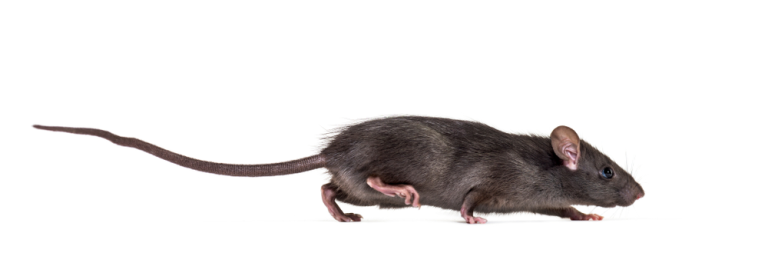A key role of the cerebellum is to control and fine-tune coordinated movement such as walking. Although walking is an unconscious behaviour, it is actually very complex and requires many systems to work together. The specific mannerisms and patterns of coordinated movement that make up how an individual walks are called gait.
Since ataxia affects cells in the cerebellum, many ataxia patients exhibit a change in their gait. This change can reduce their mobility and be disruptive to daily life. Analyzing gait using behavioural experiments in ataxia mouse models helps researchers to better understand the disease. But how exactly does one study gait patterns in a mouse?

Traditionally, a researcher measures gait by performing a footprint analysis that uses non-toxic water-coloured paint and a long strip of white paper. The front and back feet of the mouse are dipped into two different colours of paint. Then the mouse then runs across the paper leaving a trail of coloured footprints to be analyzed. This allows for several gait measurements to be taken. From this, the researcher can then determine how ataxia changed the mouse’s gait. For example, a researcher can look at if the mouse takes shorter strides than a healthy control or whether the mouse tends to walk in a more crooked manner.
Although easy to perform, footprint analysis is time-consuming and highly prone to error as the experimenter does all measurements with a ruler by hand after the mouse has run. Since gait is a complex action with many variables, some subtle differences may be difficult to detect this way. Luckily, researchers have developed several digital gait analysis systems, such as the DigiGait, CatWalk, and TreadScan systems. These digital gait devices make use of transparent corridors with cameras underneath that allow the researcher to record the running behaviour of the animal. Researchers then use software to automatically detect and analyze the footprints.
One lab has taken gait analysis even further. They developed a method to detect extremely subtle differences in gait that the human eye cannot detect. This technique, called LocoMouse, was developed by the Carey lab to analyze patterns of limb movements, rather than simply footprints. LocoMouse utilizes artificial intelligence to recognize and analyze the movement of limb, tail, and head position in a walking mouse.
Using this, the Carey lab has shown a significant difference between a healthy mouse and one with ataxia. Most importantly, the method also detects differences between different ataxia mouse models. By uncovering subtle differences in gait, researchers may better understand the different underlying physiological changes in the cerebellum in different ataxias.
It should be noted that a key pitfall of studying gait in mice is that they are four-legged while humans walk on two legs. This is important, and means that the variables that affect gait in a mouse will be different than those of a human. There may not be a direct correlation between gait changes in ataxia patients and gait changes in mice. That being said, gait analysis remains an important tool in the ataxia researchers’ toolbox. It will continue to provide critical insight into how ataxic physiology affects behaviour.
If you would like to learn more about gait analysis in mice, take a look at these resources by the Noldus Information Technology and Mouse Specifics Inc.
Snapshot written by Eviatar Fields and edited by Dr. Chandana Kondapalli.










